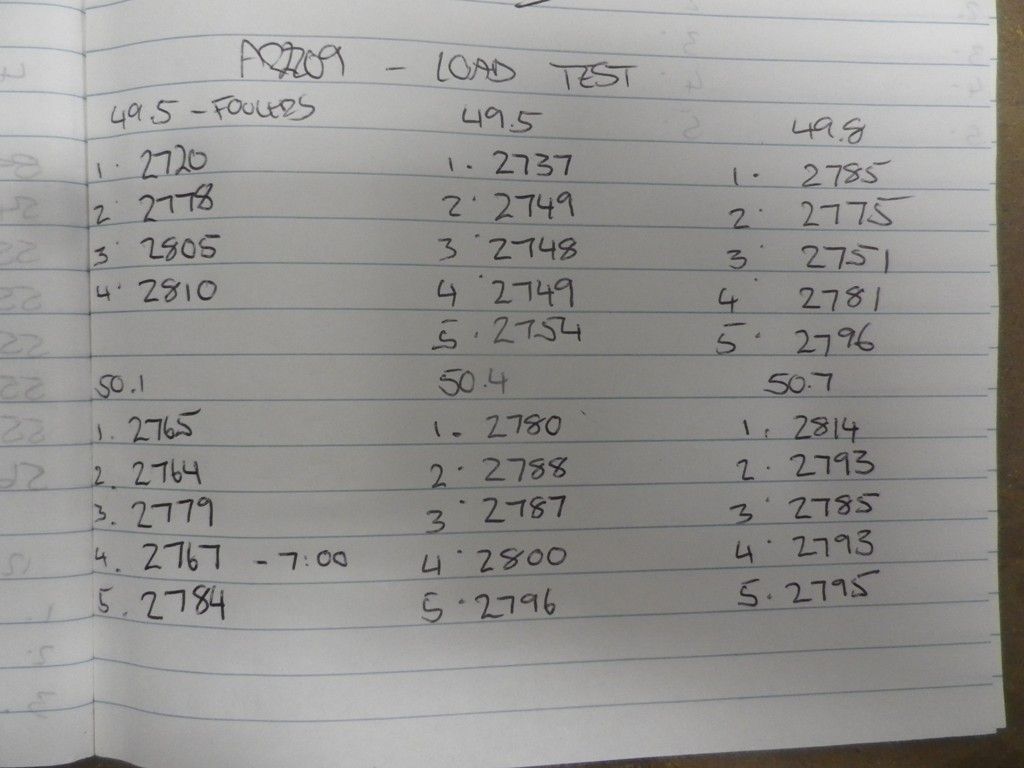Denis,
I had a quick look at the pattern.

The Macro trend is slightly negative, so anything past group 5 is going to open up with distance.
The good news is that this barrel can find a micro neutral section from 50.1 to 50.7 and is your best window for load development. May I suggest you tinker with 50.2, 50.3 and 50.4. Around 50.3 you just might get a bit of micro positive lift. Or you could take that lateral out with a tuner. The variable tuner is perfect for small changes with your barrel. Any group past 50.4 will slip into negative territory when environmental changes occur.
As I have mentioned before, that bit of “lateral” group can be reduced by playing with neck tension. It is so necessary to do this about a node. It can be done with tiny bits of free flight. Any group shape is not really a linear change because of the vibrations going up the barrel and coming back where the bullet is in the middle of them. The waves tend to stack up where they clash to form a node. Similarly this lack of seemingly logic, (its counter intuitive) applies to extreme spreads around a nodal area and your tightest extreme spread may not be your best group up short. Often when we shoot fast, the groups form beautifully and tend to be rounder and there is not so much lateral on a good tune. I think this has something to do with a plasma state of particles and may be evidenced with fouling a few inches from the end of the barrel when the heat and pressure drop and the particles change back to a solid form. But the reality is, we cannot shoot fast all the time due to observing and altering for wind and we are going to experience that lateral. So it’s best to reduce it as much as we can. Edit: I would like to point out that sometimes while waiting, we can blame a wind change for the lateral or mirage if you haven't seen it. On the other hand we can have the illusion of under correcting or overcorrecting if we do see a change and particularly when new shooters follow each shot and aim off. It can give the impression of altering on a crook shot. You must learn the rifles expected group centre and make assessments for wind or mirage based on that and coaches must know that too.
Another observation with these groups is the anti node or hollow group. Perhaps, more on that later. But could I say, that many a good barrel was thrown out in the past in the days of issued ammunition. Percy used to smile and give them to me when others rejected them. So knowledge is power. That quote is in Sweets book, from Sir Francis Bacon and it is so true.
Could I say, with groups I have examined, Tim’s had a macro positive compensation profile, Tony’s which some have not seen, had a Neutral; and now Denis’s has a a slightly negative compensation profile. We indeed have a representative set, but Denis’s has the widest window to play with and is the least sensitive barrel of the three.
When doing this type of testing, it’s a good idea to label the speed on the plot of each bullet because that is also a clue for the direction the group will form with different charges. For example take note of the low left and low right shot either side of the node with 50.1 and 50.7 respectively. These can indicate whether you are about to rise to a node or slip off one. I also use the height of these shots to determine compensation profile.
Generally, three shot groups are less informative and you can be sucked in as to the whereabouts of nodes because we tend to be drawn to clusters. That extra one or two shots in each group often paints a more realistic picture.
Also, in doing a round robin test, with say, a 45 second interval, will highlight the worst case scenario in terms of your barrel fouling or walking under warm up. This is good, because you want your gear to handle the worst case scenario best and that is what compensation tuning does. It also embodies the OCW theory in my testing because I want to be about a node that has the largest window in terms of elevation if conditions change.
The short range groups, maybe tweaked at 300 yards and 500 yards for elevation, if they need it. I usually do that with a tuner because mound angles can be a factor.
Finally, when setting up these tests at short range, it is important to watch your position when sighting changes for each target from right to left because you can induce a lateral factor because your rifle is not riding straight back. It would be good if a Guru with electrical knowledge could build a target for short range testing that could be radio controlled to wind a roll of paper through a target area so you did not have to aim off for each shot in the round robin. This would make plotting the tape so to speak and reading it so much easier.
Looking good Denis.
David.



